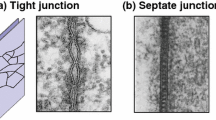Summary
Nematocytes (stinging cells) of hydra tentacles are anchored to the basement membrane by peculiar complex junctions in which a flattened tongue of an epithelial cell is interposed between the nematocyte and the basement membrane. In this paper we describe the arrangement of these junctions with emphasis on how they are related to the architecture of the epithelial cell. Each epithelial cell, called a battery cell, harbors 10–20 nematocytes and bears muscle processes that extend along the basement membrane. The epithelial cell component of the complex junction is usually a lateral extension of a muscle process. All nematocytes within a battery cell make junctions with muscle processes of the same (“resident”) epithelial battery cell despite the presence of numerous muscle processes from adjacent (“foreign”) cells. Some nematocytes make junctions with several resident processes, spanning the foreign processes to do so. Most junctions reside near the proximal ends of the muscle processes. New findings are reported on the substructure of the junctions. They are composed of aggregates of smaller elements, and the cytoskeleton within the complexes has a pronounced longitudinal organization. These observations are consistent with a suggestion that the complex junctions develop by aggregation of smaller junctional units originating elsewhere on the cells.
Similar content being viewed by others
References
Beigel-Heuwinkel U (1982) Helical fibrils in the mesoglea of a hydropolyp. Tissue Cell 14:225–230
Bialashevich KI (1914) On the structure of stinging cells of hydra. [In Russian] Warsaw University Bulletin 4:1–44
Campbell RD (1967) Tissue dynamics of the steady state growth in Hydra littoralis III. Behavior of specific cell types during tissue movements. J Exp Zool 164:379–392
Campbell RD (1985) Tissue architecture and hydroid morphogenesis: the role of locomotory traction in shaping the tissue. In: Sawyer RH, Showman RM (eds) The cellular and molecular biology of invertebrate development. University of South Carolina Press, Columbia, pp 221–238
Campbell RD (1987) Hydra lirosotna, sp. nov. (Cnidaria: Hydrozoa) from North America with comments on species clusters within the genus Hydra. Zool J Linnean Soc London (in press)
Campbell RD, Campbell JH (1971) Desmosomes. In: Reinert J, Ursprung H (eds) Origin and continuity of cell organelles. Academic Press, Berlin, pp 261–298
Campbell RD, Rahat M (1975) Ultrastructure of nematocytes and one-celled tentacles of the freshwater Coelenterate, Calpasoma dactyloptera. Cell Tissue Res 159:445–457
Chapman DM (1978) Microanalomy of the cubopolyp, Tripedalia cystophora (Class Cubozoa). Helgol Wiss Meeresunters 31:128–168
Ewer RF (1947) On the functions and mode of action of the nematocysts of hydra. Proc Zool Soc London 117:365–376
Fahmy A (1967) An extemporaneous lead citrate stain for electron microscopy. Proceedings of the 25th Anniversary Meeting of the Electron Microscopy Society of America, pp 148–149
Galey FR, Nilsson SEG (1966) A new method for transferring sections from the liquid surface of the trough through staining solutions to the supporting film of a grid. J Ultrastruct Res 14:405–410
Hufnagel LA, Kass-Simon G, Lyon MK (1985) Functional organization of battery cell complexes in tentacles of Hydra attenuata. J Morphol 184:323–341
Jickeli CF (1882) Der Bau der Hydroidpolypen. I. Über den histologischen Bau von Eudendrium Ehrbg. und Hydra L. Morphol Jahrb 8:373–416
Lenhoff HM, Brown RD (1970) Mass culture of hydra: an improved method and its application to other aquatic invertebrates. Lab Anim 4:139–154
Lyon MK, Kass-Simon G, Hufnagel LA (1982) Ultrastructural analysis of nematocyte removal in Hydra. Tissue Cell 14:415–424
Novak PL, Wood RL (1983) Development of the nematocyte juncional complex in hydra tentacles in relation to cellular recognition and positioning. J Ultrastruct Res 83:111–121
Slautterback DB (1967) The cnidoblast-musculoepithelial cell complex in the tentacles of hydra. Z Zellforsch 79:296–318
Spurr AR (1969) A low-viscosity epoxy resin embedding medium for electron microscopy. J Ultrastruct Res 26:31–43
Tardent P, Holstein T, Weber J, Klug M (1985) The morphoynamics and actions of stenotele nematocysts in hydra. Arch Sci Genève 38:401–418
Westfall JA (1970) The nematocyte complex in a hydromedusan, Gonionemus vertens. Z Zellforsch 110:457–470
Westfall JA (1973) Ultrastructural evidence for neuromuscular systems in coelenterates. Am Zool 13:237–246
Wood RL (1985) The use of hydra for studies of cellular ultrastructure and cell junctions. Arch Sci Genève 38:371–383
Wood RL, Novak PL (1982) The anchoring of nematocysts and nematocytes in the tentacles of hydra. J Ultrastruct Res 81:104–116
Author information
Authors and Affiliations
Rights and permissions
About this article
Cite this article
Campbell, R.D. Organization of the nematocyst battery in the tentacle of hydra: Arrangement of the complex anchoring junctions between nematocytes, epithelial cells, and basement membrane. Cell Tissue Res. 249, 647–655 (1987). https://doi.org/10.1007/BF00217337
Accepted:
Issue Date:
DOI: https://doi.org/10.1007/BF00217337




